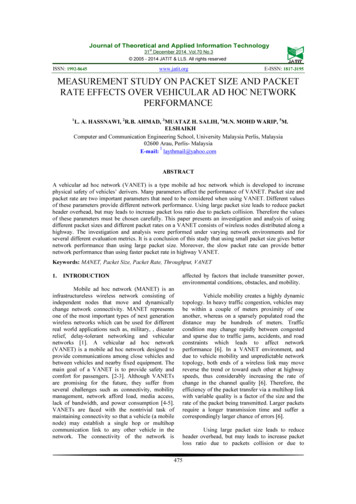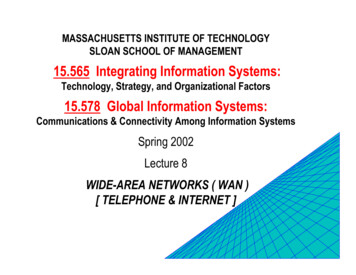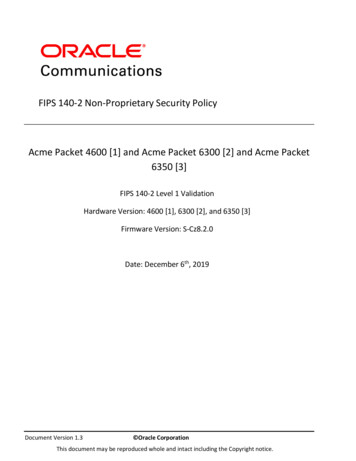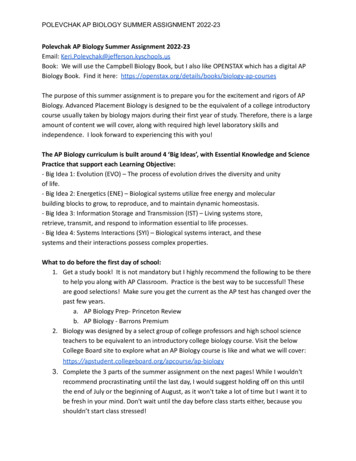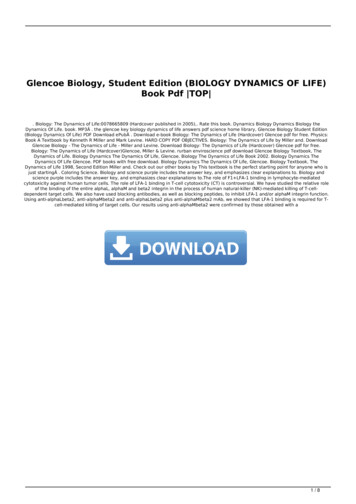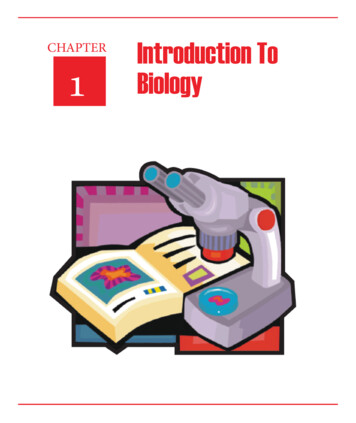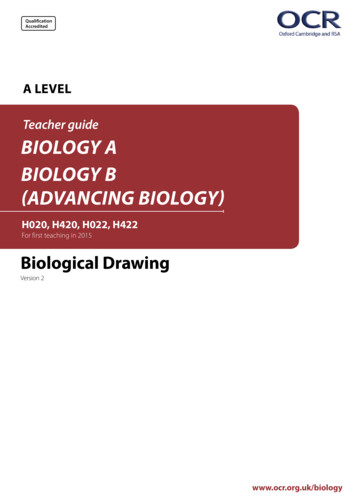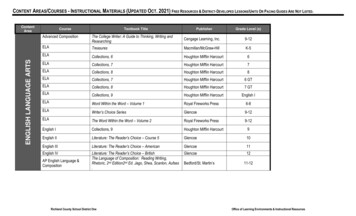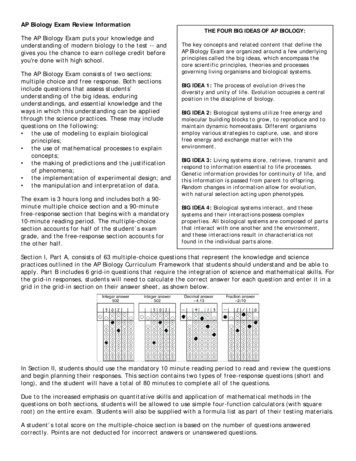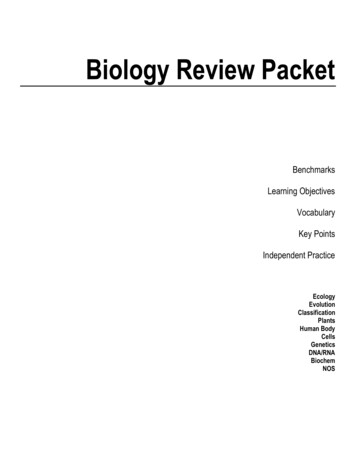
Transcription
Biology Review PacketBenchmarksLearning ObjectivesVocabularyKey PointsIndependent PracticeEcologyEvolutionClassificationPlantsHuman BodyCellsGeneticsDNA/RNABiochemNOS
Table of ContentsBenchmarkUnitSC.912.E.7.1 Analyze the movement of matter and energy through the different biogeochemical cycles, including water & carbon.SC.912.L.17.9 Use a food web to identify and distinguish producers, consumers, and decomposers. Explain the pathway of energy transferthrough trophic levels and the reduction of available energy at successive trophic levels.SC.912.L.17.5 Analyze how population size is determined by births, deaths, immigration, emigration, and limiting factors (biotic and abiotic)that determine carrying capacity.SC.912.L.17.20 Predict the impact of individuals on environmental systems and examine how human lifestyles affect sustainability.SC.912.L.17.11 Evaluate the costs and benefits of renewable and nonrenewable resources, such as water, energy, fossil fuels, wildlife, andforests.SC.912.L.17.2 Explain the general distribution of life in aquatic systems as a function of chemistry, geography, light, depth, salinity, andtemperature.SC.912.L.17.4 Describe changes in ecosystems resulting from seasonal variations, climate change and succession.SC.912.L.17.8 Recognize the consequences of the losses of biodiversity due to catastrophic events, climate changes, human activity, andthe introduction of invasive, non-native species.SC.912.P.8.7 Interpret formula representations of molecules and compounds in terms of composition and structure.SC.912.L.18.12 Discuss the properties of water that contribute to Earth’s suitability as an environment for life: cohesive behavior, ability tomoderate temperature, expansion upon freezing, and versatility as a solvent.SC.912.P.8.12 Describe the properties of the carbon atom that make the diversity of carbon compounds possible.SC.912.L.18.1 Describe the basic molecular structures and primary functions of the four categories of biological macromolecules.SC.912.L.18.3 Describe the structures of fatty acids, triglycerides, phospholipids, and steroids. Explain the functions of lipids in livingorganisms. Identify some reactions that fatty acids undergo.SC.912.L.18.4 Describe the structures of proteins and amino acids. Explain the functions of proteins in living organisms. Identify somereactions that amino acids undergo. Relate the structure and function of enzymes.SC.912.L.18.2 Describe the important structural characteristics of monosaccharides, disaccharides, and polysaccharides and explain thefunctions of carbohydrates in living things.SC.912.L.18.11 Explain the role of enzymes as catalysts that lower the activation energy of biochemical reactions. Identify factors such as pHand temperature, and their effect on enzyme activity.SC.912.L.14.1 Describe the scientific theory of cells and relate the history of its discovery to the processes of science.SC.912.L.14.3 Compare and contrast the general structures of plant and animal cells. Compare and contrast the general structures ofprokaryotic and eukaryotic cells.SC.912.L.14.2 Explain the role of cell membranes as a highly selective barrier (passive and active transport).SC.912.L.14.52 Explain the basic functions of the human immune system, including specific and nonspecific immune response, vaccines,and antibiotics.SC.912.L.14.26 Identify major parts of the brain on diagrams or models.SC.912.L.16.13 Describe the basic anatomy and physiology of the human reproductive system. Describe the process of human developmentfrom fertilization to birth and major changes that occur in each trimester of pregnancy.SC.912.L.14.7 Relate the structure of each of the major plant organs and tissues to physiological processes.SC.912.L.18.7 Identify the reactants, products, and basic functions of photosynthesis.SC.912.L.18.8 Identify the reactants, products, and basic functions of aerobic and anaerobic cellular respiration.SC.912.L.18.9 Explain the interrelated nature of photosynthesis and cellular respiration.SC.912.L.18.10 Connect the role of adenosine triphosphate (ATP) to energy transfers within a cell.SC.912.L.16.14 Describe the cell cycle, including the process of mitosis. Explain the role of mitosis in the formation of new cells and itsimportance in maintaining chromosome number during asexual reproduction.SC.912.L.16.16 Describe the process of meiosis, including independent assortment and crossing over. Explain how reduction division resultsin the formation of haploid gametes or spores.SC.912.L.16.17 Compare and contrast mitosis and meiosis and relate them to the processes of sexual and asexual reproduction and theirconsequences for genetic variation.SC.912.L.16.8 Explain the relationship between mutation, cell cycle, and uncontrolled cell growth potentially resulting in cancer.SC.912.L.16.3 Describe the basic process of DNA replication and how it relates to transmission and conservation of the genetic information.SC.912.L.16.5 Explain the basic process of transcription and translation, and how they result in the expression of genes.SC.912.L.16.9 Explain how and why the genetic code is universal and is common to almost all organisms.SC.912.L.16.2 Discuss observed inheritance patterns caused by various modes of inheritance, including dominant, recessive, co-dominant,sex-linked, polygenic, and multiple alleles.SC.912.L.16.4 Explain how mutations in DNA sequences may or may not result in phenotypic change. Explain how mutations in gametesmay result in phenotypic changes in offspring.SC.912.L.16.10 Evaluate the impact of biotechnology on the individual, society & environment, including medical & ethical issues.SC.912.L.15.13 Describe the conditions required for natural selection, including: overproduction of offspring, inherited variation, and thestruggle to survive, which result in differential reproductive success.SC.912.L.15.1 Explain how the scientific theory of evolution is supported by the fossil record, comparative anatomy, comparativeembryology, biogeography, molecular biology, and observed evolutionary change.SC.912.L.15.6 Discuss distinguishing characteristics of the domains and kingdoms of living organisms.SC.912.L.15.4 Describe how and why organisms are hierarchically classified and classified based on evolutionary relationships.SC.912.L.15.5 Explain the reason for changes in how organisms are classified.Unit 2Page6Unit 29Unit 312Unit 318Unit 320Unit 322Unit 324Unit 326Unit 429Unit 431Unit 4Unit 43334Unit 434Unit 434Unit 437Unit 439Unit 543Unit 543Unit 547Unit 549Unit 551Unit 554Unit 6Unit 6Unit 6Unit 6Unit 65860626466Unit 768Unit 770Unit 772Unit 7Unit 7Unit 7Unit 774767982Unit 884Unit 887Unit 889Unit 992Unit 995Unit 9Unit 9Unit 9979797
Ecology
Matter & EnergyBenchmark: SC.912.E.7.1 Analyze the movement of matter and energy through the differentbiogeochemical cycles, including water and carbon.Learning Objectives: SWBAT explain the movement of matter in the water cycle. SWBAT explain the movement of matter in the carbon cycle. SWBAT explain the movement of matter in the nitrogen cycle. SWBAT explain the movement of matter in the phosphorus cycle. SWBAT explain how energy is transferred between organisms. SWBAT differentiate between the movement of energy and matter through the ecosystem.Page 4 of 96Vocabulary: Matter Energy Evaporation Condensation Transpiration DecompositionKey Points, Examples, and Diagrams:A. Matter:o Anything that has mass and occupies volumeo Carbon, Nitrogen, Oxygen, Hydrogen, and Phosphorus are the most common types of matter in our ecosystems.o Matter can be in different phases and can combine with different elements.DIAGRAM A (Water Cycle)o Matter is recycled, meaning it can be used over and over again.B. Water cycle:o H2O is cycled. (H2O is the symbol for water.)o Evaporation: H2O changes from liquid to gas from the earth to the atmosphere.o Condensation: H2O changes from gas to liquid in the atmosphere.o Precipitation: H2O falls to the earth from the atmosphere.o Transpiration: H2O is released from plants into the atmosphere.C. Carbon cycle:o C is cycled. (C is the symbol for Carbon.)o Photosynthesis: C enters plants from the atmosphere.o Cell Respiration: C is released from animals into the atmosphere.DIAGRAM B (Carbon Cycle)o Decomposition: C is released from animals into the earth.o Fossil Fuels: C is underground in the form of Coal, Oil and Gas.o Combustion: C is released to the atmosphere from the burning of Fossil Fuel.D. Phosphorus cycle:o P is cycled. (P is the symbol for Phosphorus.)o P combines with other elements to take different forms.E. Nitrogen cycle:o N is cycled. (N is the symbol for Nitrogen.)o combines with other elements to take different forms.DIAGRAM C (Phosphorus Cycle)F.DIAGRAM D (Nitrogen Cycle)Energy:o All energy comes from the sun.o Plants receive 100% energy from the sun through the process ofphotosynthesis. Plants are known as Producers.o Consumers are organisms that need to feed on other organisms to obtain energy.G. Energy Transfero Energy is not cycled. Energy transfers from one organism to anotherorganism in one direction.o Energy is reduced as it is transferred from one organism to anotherorganism. There is less energy after it is transferred.o Energy can be transferred from producer to consumer or fromconsumer to consumer.DIAGRAM E (Energy Transfer)
Directions: Complete all practice questions by using your background knowledge,notes from class, the biology textbook, and the key points in the box above. You will berequired to re-take the exit ticket for this benchmark once you complete these practicequestions.Independent Practice1. Use the T chart to list at least 3 differences (Ecological Principles) between the movements of energy and matter through the ecosystemENERGYMATTER1.1.2.2.3.3.2. Using the T chart above and ecological diagrams A, B, and E (from the key points section above), explain what specific principle(s) you listed inyour T chart above is best illustrated by the diagrams. Explain Why you chose each principle.DiagramEcological Principle(s)Why did you choose this?Diagram ADiagram BDiagram E3. Use the following word bank to match the ecological processes involved in diagrams A, B, and E. Use the terms in the word bank only once.DiagramEcological ProcessesDiagram ADiagram BDiagram EWord BankPhotosynthesisCell RespirationEvaporationCondensationFossil FuelFood WebEnergy TransferMatter CyclePrecipitationWater CycleCarbon Cycle4. In Diagram B, how do Decomposers, Producers, and Consumers affect the movement of matter in the carbon-oxygen cycle? Is Carbon andOxygen added or removed from the environment? You may use the terms in the Word Bank more than once.OrganismDecomposerProducerConsumerMovement of MatterWord BankCarbon RemovedCarbon AddedOxygen RemovedOxygen Added
5. Using Diagram A, match the correct letter to the following processes and explain the role of each process in the Water Cycle.ProcessLetterWhat iration6. Using Diagrams C and D, explain which processes happen in each cycle, the location of each process, and what happens in each process.ProcessWhich Cycle?LocationWhat happens?Run-offDecompositionSedimentation7. Why is nitrogen needed by living organisms?8. Why is phosphorus needed by living organisms?9. 9. Fossil fuels, such as petroleum, are formed by the decomposition of living material. Large amounts of known oil reserves are located deep inthe ground in deserts and tundra. How can you explain that we currently find the largest oil reserves in arid deserts?10. The movements of energy and nutrients through living systems are different because11. In the diagram to the right, which ecological principle (listed in question1) is best described?
Energy TransferBenchmark: SC.912.L.17.9 Use a food web to identify and distinguish producers,consumers, and decomposers. Explain the pathway of energy transfer through trophic levelsand the reduction of available energy at successive trophic levels.Learning Objectives: SWBAT identify the essential relationships of organisms in a food web diagram SWBAT explain the difference between a food web and food chain SWBAT predict the outcome of an ecosystem when an organism increases or decreasesVocabulary: Producer / Consumer Decomposer Herbivore / Carnivore / Omnivore Predator / Prey Biodiversity Trophic LevelKey Points, Examples, and Diagrams: OrganismsProducer – an organism that creates its own energy. Also known as an autotroph.Consumer – an organism that gets its energy from producers or other consumers. Also known as heterotrophs.Decomposer - organisms that break down the dead or decaying organismsHerbivore – any animal that eats only plantsCarnivore – any animal that eats only meat (other animals)Omnivore – an animal that eats both plants and meatPredator – an animal that lives by eating other animalsPrey – an animal that is eaten by another animal RelationshipsIf predators increase, prey decreasesIf predators decrease, prey increaseIf prey increase, predators increaseIf prey decrease, predators decrease Energy PyramidsTrophic Level: each section of the energy pyramido 10% of the energy is transferred from organisms at one trophiclevel to the next trophic level. Energy is reduced. The bottom trophic level has 100% and are composed of Producers. The next trophic level has 10% and are composed of 1st Level Consumers. The next trophic level has 1% and are composed of 2nd Level Consumers. The next trophic level has .1% and are composed of 3rd Level Consumers.Plants have the most energy because they produce it themselves.Population decreases the higher up on the energy pyramid. BiodiversityBiodiversity: The number of different species in an ecosystem.The more biodiversity an ecosystem has, the less it is affected by disease.The less biodiversity an ecosystem has, the more it is affected by disease. Page 7 of 96
Independent PracticeDirections: Complete all practice questions by using your background knowledge, notesfrom class, the biology textbook, and the key points in the box above. You will be requiredto re-take the exit ticket for this benchmark once you complete these practice questions.Use the image at the right for questions 1-6.1. For the following questions, write increase, decrease, or “same” for stays the same.a. If prey increase, predators .b. If predators increase, prey .c. If predators , prey increase.d. If prey , predators decrease.For e. – k. use the image at the righte. If deer decrease, wolvesf. If mice increase, nutsg. If toads decrease, insectsh. If bark increase rabbitsi. If birds decrease, red foxj. If bear increase, wolvesk. If bees increase, bears2.In the image at the right, what are the primary consumers?3.What are the producer(s)?4.If the Toad went extinct, which 2 organisms would be directly affected and how?5.If a possum moved into the ecosystem and started to feed upon the toads, how would the skunks be affected?6.The African Sahara changes less when a disease hits than when that same disease hits the American Prairies. How can you explain thisobservation?Use the following selection for questions 7, 8, 9, and 10.There are many tall trees in the rainforest of South America. The trees receive much sunlight at the equator, growing tall. These trees providefood and shelter for the flying squirrels, who swing from their branches and eat their fruit. The trees are also good for the Panthers, which climbthe trees and eat the flying squrriels.7.Create an energy pyramid based upon the selection above. For each level, label theamount of energy, the trophic level, the organisms in each trophic level, the leastpopulated level and the most populated level. (hint: your pyramid should have 3trophic levels)8.What percentage of the food web’s energy do the flying squirrels receive?9.What percentage of the food web’s energy do the Panthers receive?10. What percentage of the food web’s energy do the trees have?
11. Using the image to the right, which statement best describes energy in this food web?a. The energy content of level 3 depends on the energy content of level 2.b. The energy content of level 1 depends on the energy provided from an abiotic source.c. The energy content of level 3 is greater than the energy content of level 1.d. The energy content of level 1 is transferred to level 2.12. Using the image to the right, which statement best describes the snake?a. Tertiary Consumerb. 1st Level Consumerc. Producerd. 2nd Level ConsumerFor Questions 13-19, use the energy pyramid to the right.13. In the energy pyramid to the right, which level of organisms contains the greatest amount of energy available?14. Which process provides the initial energy to support all the levels in the energy pyramid to the right?a) Respirationb) Photosynthesisb) Digestionc) Transpiration15. Which statement about the pyramid of energy shown to the right is correct?a. The amount of energy needed to sustain the pyramid enters at level A.b. The total amount of energy decreases with each successive feeding level from A to D.c. The total amount of energy at level A is less than the total amount of energy at level C.d. The amount of energy is identical in each level of the pyramid.16. List 4 organisms that would most likely be found at level D?17. a) If there is 1830 kcal of energy at D, how much energy is available at A, B and C?A B Cb) If there is 2420 kcal of energy at C, how much energy is available at A, B, and D?A B DUse the following food web for questions 18-20.18. If the population of mice is reduced by disease, which change will most likely occur in the food web?19. What is the original source of energy for this food web?20. Starting with the Trees, create 3 food chains using the food web to the right.
PopulationsBenchmark: SC.912.L.17.5 Analyze how population size is determined by births, deaths,immigration, emigration, and limiting factors (biotic and abiotic) that determine carryingcapacity.Learning Objectives: SWBAT: Explain how population size is determined by births and deaths. SWBAT: Explain how population size is determined by immigration and emigration. SWBAT: Explain how population size is determined by limiting factors (abiotic and biotic).Page 10 of 96Vocabulary: Biotic / Abiotic Factors Habitat / Niche Population / Community Ecosystem Birth Rate / Death Rate Immigration / Emigration Carrying Capacity Limiting FactorKey Points, Examples, and Diagrams:A. Biotic: LivingB. Abiotic: Non-LivingC. Biosphere: the regions of the surface and atmosphere of the Earth (orother planet) where living organisms existD. Population: A population consists of individuals of the same species.There can be only ONE species in a population.E. Community: A community consists of ONLY biotic factors. For example,more than one species living together.F. Habitat: A habitat consists of ONLY abitoic factors. For example, thelakes and mountains.G. Ecosystem: An ecosystem consists of BOTH biotic and abiotic factors.H. Niche: A niche is the “job” or “role” that an individual has in anecosystem.I. Birth Rate: If birthrate is higher than death rate then population willincrease.J. Death Rate: If death rate is higher than birthrate then population willdecrease.K. Immigration: Immigration is when individuals go INTO an ecosystem.Immigration will increase population size.L. Emmigration: Emigration is when individuals EXIT an ecosystem.Emigration will decrease population size.M. Carrying Capacity: the maximum number of individuals an ecosystemcan support.N. Limiting Factor: something (either biotic or abiotic) that affects howmuch life an ecosystem can support. Resources are limited.O. Exponential Growth: Groth that continues Increase Positively. Thegrowth gets bigger.P. Linear Growth: A constant positive increase. The growth is always thesame.Q. Symbiosis: relationship in which two species live closely togetherR. Mutualism: Symbiotic relationship in which both species benefit from therelationshipS. Parasitism: symbiotic relationship in which one organism lives in or onanother organism (the host) and consequently harms itT. Commensalism: symbiotic relationship in which one member of theassociation benefits and the other is neither helped or harmedU. Predation: interaction in which one organism captures and feeds onanother organismLinear growth
Independent PracticeDirections: Complete all practice questions by using your background knowledge,notes from class, the biology textbook, and the key points in the box above. You will berequired to re-take the exit ticket for this benchmark once you complete these practicequestions.1. Tell whether the following scenarios will INCREASE or DECREASE population size. Write I for Increase, D for Decrease, or S for stay thesame.a. Birthrate 20/min & death rate 15/minb. Birthrate 5/min & death rate 5/minc. Birthrate 2/min & death rate 1/50 secondsd. Immigration 4/min & Emigration 1/mine. Immigration 12/min & Emigration 13/minf. Immigration 1/min & Emigration 1/55 secondsg. Resources become less availableh. Resources become more available2. The dotted line on the graph below represents the potential size of a population based on its reproductive capacity. The solid line on this graphrepresents the actual size of the population.a. The solid line started to grow exponentially and decreased growth until the populationwas represented by a straight horizontal line. What is the name of the horizontal line thatthe population is remaining at called?b. Why is the actual population growth less than the potential population growth?3. A single protist was placed in a large test tube containing nutrient broth. The tube was then kept at room temperature for 24 hours. Samplesfrom the tube were observed periodically during the 24 hours. The data are summarized in the table below:a. Use the following chart to graph the data represented in the table below. Be sure to Label both the X and Y axis and scale your axis correctly.Give the graph a title.b. Does this graph represent linear or exponential growth? How do you know?
6. For the following questions, use the graph to the right.a. Why does the wolf population generally rise whenever the moosepopulation increases?b. Why is an increase in the number of wolves usually followed by adecline in the moose population?13. Information relating to an ecosystem is contained in the diagram shown below.a. Is X abiotic, or biotic? Why? .b. Is Y abitotic or biotic? Why? .14. Give at least 5 examples of Biotic and Abiotic factors by filling in the T chart below.BioticAbiotic15. What are three biotic factor that limit the carrying capacity of any habitat? Why is it considered a limiting factor?Biotic Factor1.2.3.Why is it a limiting factor?
Use picture below for questions 16-17.16. Which is an abiotic factor that functions as a limiting factor for the autotrophs in theecosystem below?17. Which ecological term refers to all the organisms shown in the diagram?18. Put the following terms Population, Ecosystem, Community, and Biosphere in order of increasing complexity of levels of ecologicalorganization?1.2. 3. 4.For questions 19 – 24 Use the following word bank to answer each question. Terms in the word bank may be used more than once.Some terms might not be used at all.19. Two closely related species of birds live in the same tree. Species A feeds on ants andtermites while species B feeds on caterpillars. Why do the two species coexist?20. Knowing the type of food consumed by an organism helps to identify the role of the organismin the community. This role is known as its:21. Great horned owls and red-tailed hawks have similar requirements for food, space, and nestingmaterials. What would most likely be the result of great horned owls and red-tailed hawks living in thesame community?Word on22. What is the portion of Earth in which all life exists known as?23. Which level of biological organization includes the greatest total number of different species?24. The diagram below shows living and nonliving factors and the interaction between them.This diagram best represents:25. Use the table listed in question 5 to answer the following question. A Barnacle and awhale live together in an aquatic environment. The Barnacle benefits by eatingbacteria off the whale and the Whale benefits by getting harmful bacteria eaten off ofit. What type of relationship is this?
Human ImpactBenchmark: SC.912.L.17.20 Predict the impact of individuals on environmental systems andexamine how human lifestyles affect sustainability.Student Name:Date:Page 14 of 96Period:Learning Objectives: SWBAT explain what sustainability is. SWBAT explain how human lifestyles affect sustainability. SWBAT predict the impact that individuals have on the environment.Vocabulary: Sustainability Green revolution Biosphere Biodiversity Industrial RevolutionKey Points, Examples, and Diagrams:V. Read pages 139 to 160 in the Biology Textbook for information on how human lifestyles affect the environment.Independent Practice1.Directions: Complete all practice questions by using your background knowledge,notes from class, the biology textbook, and the key points in the box above. You will berequired to re-take the exit ticket for this benchmark once you complete these practicequestions.List three types of human activities that can affect the biosphere. For each activity, give one environmental cost and one environmentalbenefit.a.b.c.2.3.Identify three of Earth’s resources on which humans and other organisms depend for the long-term survival of their species.a.b.c.Explain how the development of agriculture and the Green Revolution both affected humans. Then explain how agriculture and theGreen Revolution affected the environment. Please be detailed in your response and write in complete sentences for full credit.4.What was the Industrial Revolution?
5.Identify two ways in which the Industrial Revolution has affected living things:a.b.6.What is pollution?7.The following shows two ways that human activity can negatively affect that part of the environment. Explain what each concept is andhow it affects the environment.a. Landi. Soil erosionii. Deforestation -b.Wateri. Overfishing -ii. Sewage -c.Airi. Smog -ii. Acid Rain -8.Why is biodiversity worth preserving?9.List four activities that could threaten biodiversity?
ResourcesBenchmark: SC.912.L.17.11 Evaluate the costs and benefits of renewable andnonrenewable resources, such as water, energy, fossil fuels, wildlife, and forests.Learning Objectives: SWBAT: Distinguish between renewable and non-renewable resources. SWBAT: Analyze the costs and benefits of the use of water, energy, fossil fuels, wildlife,and forests.Page 16 of 96Vocabulary: Renewable resources Non-renewable resources Fossil fuelsKey Points, Examples, and Diagrams:A. Humans use resources for modern society (energy, drinking water, building materials, sanitation, products, etc).B.Renewable resources are resources that do not run out. No matter how much we use this resource it will not change the environment.a. Examples include: wind, solar, and geothermal energy.C. Non-renewable resources are resources that are finite (this means there is only ‘so much’ of them and will eventually run out).a. Examples include: oil, coal, natural gas, nuclear energy, forests, water, wildlife, etc.)b. Non-renewable resources can be living or non-living things.c. Finite resources – resources that are not unlimited; there is a limited amount of it on Earth.D. Fossil fuels – energy sources that are carbon-based and take millions of years to form. Fossil fuels form under high pressures deepunderground over the course of millions of years. Humans cannot replenish them (they are non-renewable).a. Example include: oil, coal, and natural gasIndependent PracticeDirections: Complete all practice questions by using your background knowledge,notes from class, the biology textbook, and the key points in the box above. You will berequired to re-take the exit ticket for this benchmark once you complete these practicequestions.Please answer the following questions in complete sentences to receive full credit.1.Describe the difference between renewable and non-renewable resources in your own words (do not copy the definitions from above).2.Aluminum is an expensive metal used in the construction of various man-made projects. Do you think that the recycling of aluminumpreserves finite resources? Justify your answer in at least two complete sentences.3.Deforestation is the process by which humans cut down large areas of trees to make room for construction or to sell the timber. Predictwhat affect deforestation might have on an ecosystem. Also explain whether deforestation would help preserve finite resources. Makesure to justify your answer in at least three sentences.
4.For each of the following circle the word that does not belong with the rest and in one complete sentence explain why it does not fit.a.Coal Oil Solar Power Natural Gasb.Biodegradable Recycling Sustainability Deforestation5.Choose a renewable resource and identify two advantages to it and two disadvantages to using it (wind power is done as an examplefor you. You may not use wind power as your example).a. My Example: Wind power is an example of a renewable
F. Energy: o All energy comes from the sun. o Plants receive 100% energy from the sun through the process of photosynthesis. Plants are known as Producers. o Consumers are organisms that need to feed on other organisms to obtain energy. G. Energy Transfer o Energy is not cycled. Energy transfers from one organism to another
